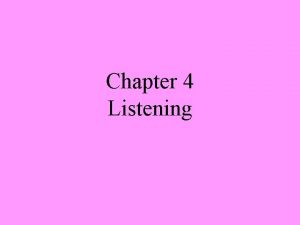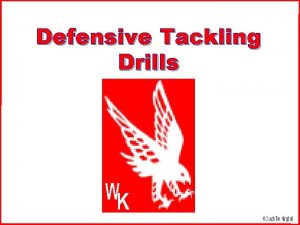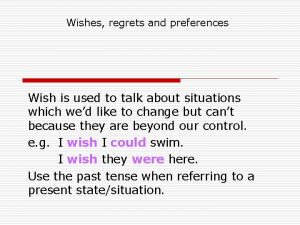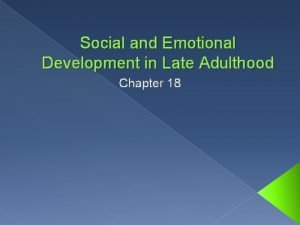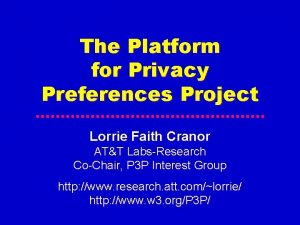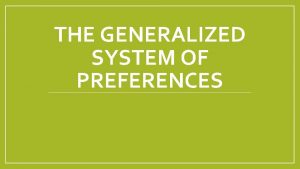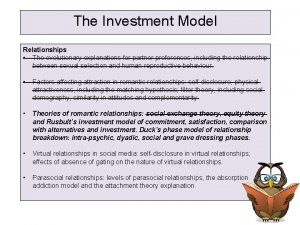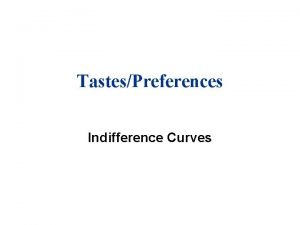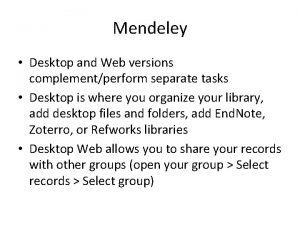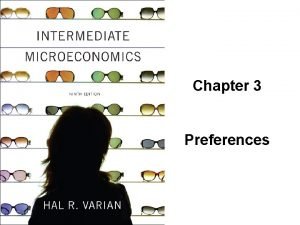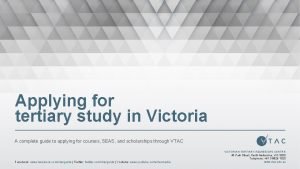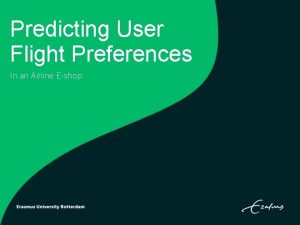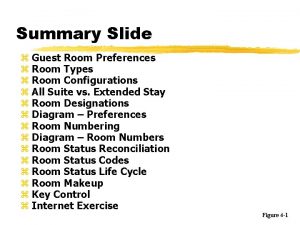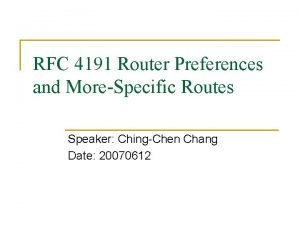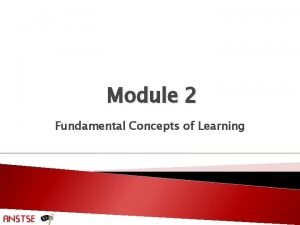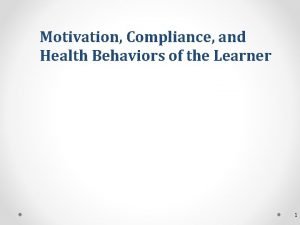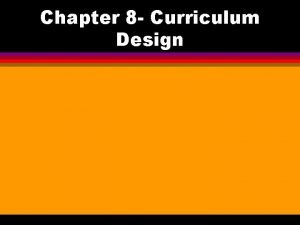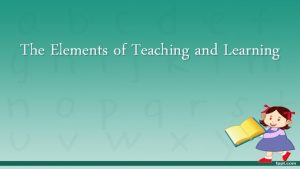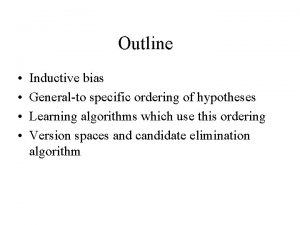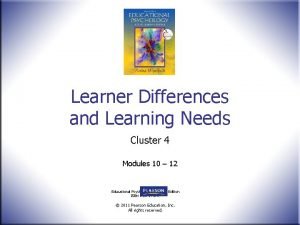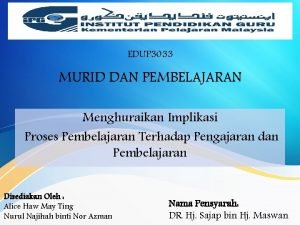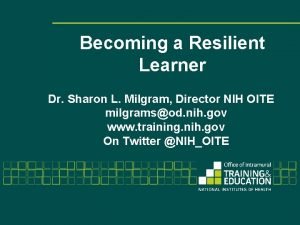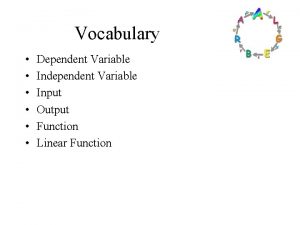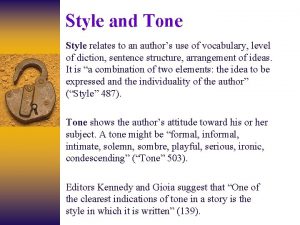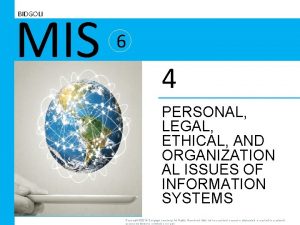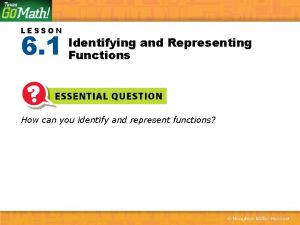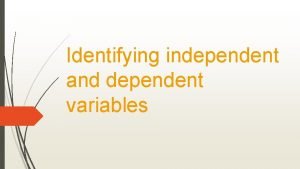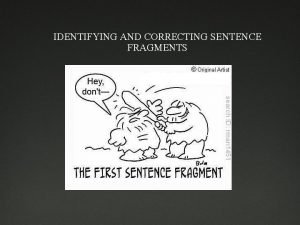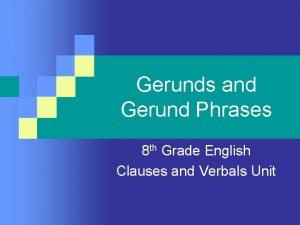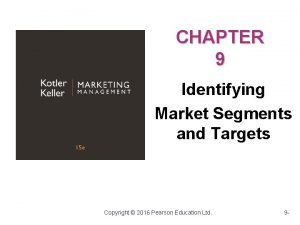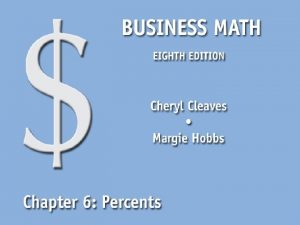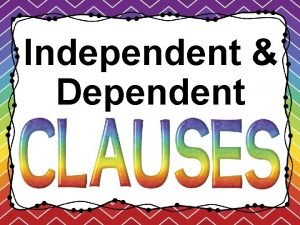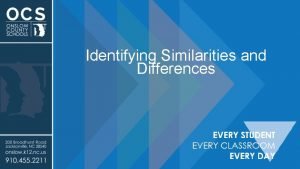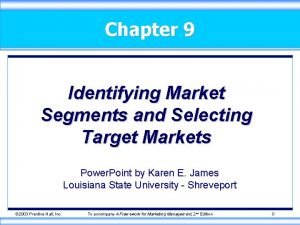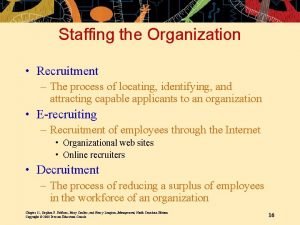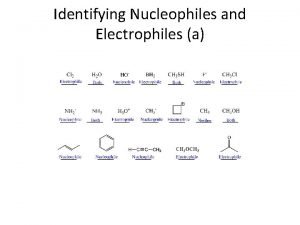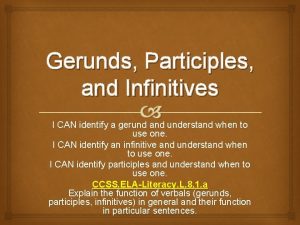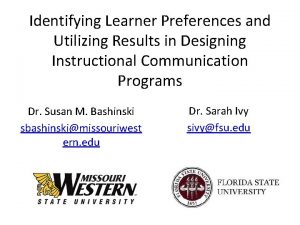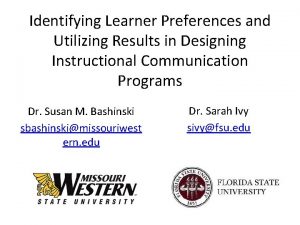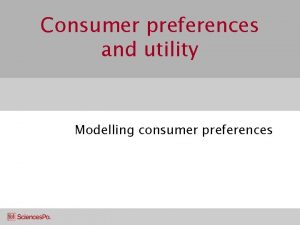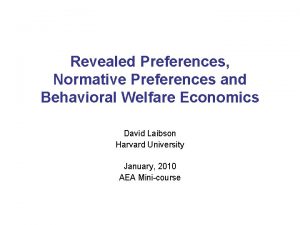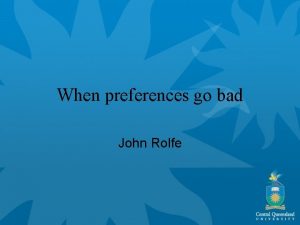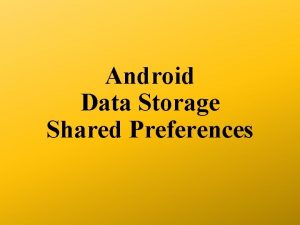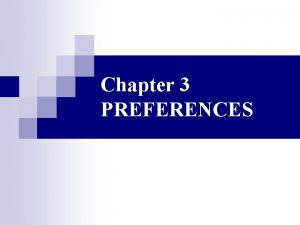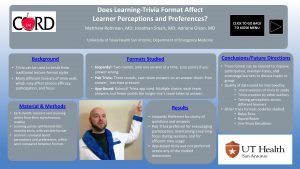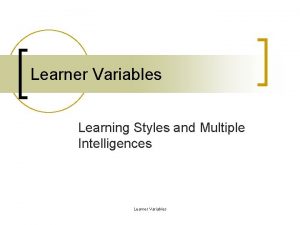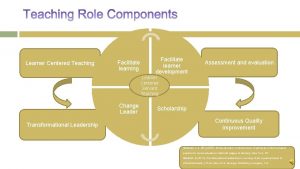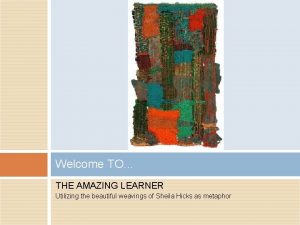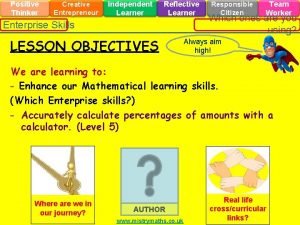Identifying Learner Preferences and Utilizing Results in Designing

































































- Slides: 65

Identifying Learner Preferences and Utilizing Results in Designing Instructional Communication Programs Dr. Susan M. Bashinski sbashinski@missouriwest ern. edu Dr. Sarah Ivy sivy@fsu. edu

Overview • Purpose and focus of today’s webinar • Research on preference assessment • Case Study: Conducting a variety of preference assessments for a learner with deafblindness • Using preferences to promote communication development

Purpose and Focus • Over-arching goal: To demonstrate how the use of data from a learner’s preference assessment can be effectively combined with the results from a learner’s communication skills assessment to build the foundation for an appropriate, powerful communication program

Purpose and Focus (cont. ) • Many learners with deafblindness move more slowly through the developmental phase of using a variety of behaviors intentionally—but NOT in an intentionally communicative way • Young children who are neurotypical generally move through this phase relatively quickly— and without direct instruction! • Development of intentional communication is a critically important, but very challenging task

Two Key Concepts

Two Key Concepts - #1 Behavior IS communication!

Key Concept #1 Two primary ways to view the overt behaviors learners demonstrate…. through a “BEHAVIORAL” filter or through a “COMMUNICATION” filter. Which filter do YOU use?

Two Key Concepts - #2 Intentionality Development Defined as: Deliberate pursuit of a goal, as well as the means to obtain the goal

Key Concept #2 Two primary elements for characterizing a learner’s overt behaviors, in terms of “INTENTIONALITY. . ” 1. 2. Intentional behavior Intentional communication (means to have impact on another person, not just objects)

Sequence of Intentionality Development For the purposes of today’s webinar, we shall identify and focus on these primary stages: • • • (Nonintentional [or preintentional]) Intentional behavior Intentional unconventional communication Transition to conventionality Transition to intentional conventionality

Nonintentional / Preintentional • In this stage, a learner is neither deliberately pursuing a goal nor aware of a means to obtain the goal • Behaviors are idiosyncratic • A communication partner must interpret the learner’s behaviors as if they were intentional (Consistent, repeated interpretations by partners, over time, will shape intentionality. )

Intentional Behavior • Behavior IS under the learner’s control (i. e. , intentional) • Behavior is NOT used to communicate intentionally • Behavior IS meaningful in context The learner does not realize she can use these behaviors to control another person’s behavior.

Intentional Unconventional Communication • Behavior IS intentionally communicative • Intentional communication means to have an impact on another person, not just on objects • NOT symbolic • “Unconventional” because these forms are not acceptable to use as grow older

Transition to Conventionality • Behavior IS used to intentionally communicate • Conventional gestures / vocalizations • Communicative messages are understood by members of the same culture • Communicative forms are socially acceptable to use as grow older

Transition to Intentionality Conventionality • Partner’s responsibility for success of a communication interaction is diminished • Communicative context is important, but less so than in the nonsymbolic stage • Learner is likely to demonstrate concrete symbolic expressions (i. e. , with 3 -D objects)

As we move now to a critical examination of PREFERENCE ASSESSMENT, it is critical to remember that…. Communication is both a skill and a sensorimotor experience And how very important it is to…. Maximize the learner’s sensory access.

Before we continue…. QUESTIONS?

Importance of Preferences Incorporating preferences in instruction can be both motivating and reinforcing • Increase engagement and interest • Use reinforcers to increase skill level • Decrease problem behaviors *Students with deafblindness often have a limited repertoire of preferences

Preference Assessment Methods Indirect Assessments • Interviews • Observations Research shows direct assessments are more accurate than indirect assessments Parents tend to inaccurately predict preference for unfamiliar items (Kenzer & Bishop, 2011) Direct Assessment • Single Stimulus • Multiple Stimulus with and without Replacement • Pairwise or forced choice • Free Operant • Reinforcer Assessment

Findings from Virues-Ortega et al. (2014) Related to Sensory and Motor Disability • Teacher concern about adapting PA methods for learners with profound disabilities, particularly with VI, motor disability (MD), and difficult behaviors • Participants included learners with VI (7 studies) or deafness (1 study), but not deafblindness • Eye gaze and emotional behaviors (indirect responses) used more frequently for learners with VI and/or MD • Pairwise assessments most often used for VI/MD

Decision Making: Type of results needed (e. g. , tangible, hierarchy), student characteristics (purely behavioral), time constraints Virues-Ortega et al. , 2014

Case Study: John 7 Years old Chromosomal anomalies 20/200 or worse with correction Binaural hearing loss (at least 70 d. B) Able to actively reach, grasp, manipulate SIB-R showed age equivalence of 5 -7 months Majority of John’s behaviors seem to be intentional, though only a small percentage to be intentional unconventional communication • Music, lights, scratching, rolling, kicking • •

Scenario 1: engagement or selection response requires intentionality, which student does not have

IRPA: Indirect/idiosyncratic response PA Scenario 2: engagement or selection does not require intentionality, and student can select with reach and grasp

IRPA: Indirect/idiosyncratic response PA Scenario 3: DB precludes student’s ability to “select” without exploration, therefore we rely on engagement measured by emotional response

Preference Assessment Procedures (adapted from Picture Exchange Communication System) 1. Interviews with parents and teacher 2. Free play observations at home and school 3. Single stimulus preference assessments – Selection responses – Indices of happiness, protest, and rejection *Parents also predicted preferences from direct assessment

Research Questions • Can the manualized Picture Exchange Communication System (PECS) preference assessment procedures be used to identify tangible preferences for a unique learner with deafblindness? • Can the preference assessment procedures be adapted to obtain useful information regarding learner preferences?

Interviews 1. List up to 10 items for each category. Include only those items that your student or child currently enjoys (or dislikes for the final category). Then number each item from most to least preferred (with most preferred being 1) within each category. 2. Then rank order items/activities across categories.

Interview Results Rank Parents Teacher Summary 1 Grandpa (tickles, snuggles, bounces) Tickles Proprioceptive: tickles, snuggles, bounces, deep pressure, drums 2 Music (gospel, deep voice, country) Floor time (mat) Proprioceptive: tickles, snuggles, bounces, deep pressure, drums 3 Floor time (carpet, tile) Floor time (tile) Proprioceptive: tickles, snuggles, bounces, deep pressure, drums 4 Tickles Scratching textures Tactual: breeze, water stuff, scratching textures, floor time 5 Peek-a-boo Repetitive movement Tactual: breeze, water stuff, scratching textures, floor time 6 Sweet potatoes Swinging Tactual: breeze, water stuff, scratching textures, floor time 7 Snickerdoodle cookies Close contact, deep pressure Vestibular: repetitive movement, swing 8 Grapes Drums Vestibular: repetitive movement, swing 9 Grandma’s potato salad Water stuff Auditory: music, drums 10 Meatloaf Parachute (breeze) Food

Activities in Free Play • • Colorful, easy to grasp, O-ball Shiny mylar pom Rattle I want to observe your child/student in a free play situation to see how she/he Lever toy might choose to spend his/her time. Your child/student does not have to play with these items. This is free play. He can spend his time playing anything he wants. Please help your child/student only if he needs help. If your child/student requests to play with you, you can play with him as you typically would. We want this to be as natural as possible. Are you ready?

Single Stimulus Assessments (1 st) Allow student to experience item for 15 -30 seconds – This will depend on the access abilities of the student and the qualities of the item. Allow student to experience all qualities of the item (see item descriptions) allowed by the student’s abilities. Show student how to operate item if appropriate. Keep focus on item, not social interaction. The intent is to get the student to understand the properties of the item. If student uses item in an inappropriate manner, block and/or redirect after 2 s. Record if student: • Rejected (If reject, go to next trial) • Had no reaction • Showed signs of pleasure • Reaches for within arm distance

Single Stimulus Assessments (2 nd) Stop operation of item and pull item away from student out of arms reach (do not grab item), still within line of vision, for 5 seconds Record if student: • Tried to obtain when out of reach • Protested when you stopped the experience

Single Stimulus Assessments (3 rd) Present item in accessible manner for up to 20 seconds, but do not force or prompt student to take the item – Alert student to the presence of the item, either visually, auditorily (e. g. , turn on/off quickly, crinkle wrapper), or tactually (e. g. , quickly touch to students hand pull away). Be thorough in your attempt. The intent is to let student know item is available, but that he/she has to indicate desire for item. Record if student: • Reaches for within arm distance • Take item again

Single Stimulus Assessments (4 th) Release item if apprehended, but do not praise student for accepting. If taken, shape student behavior as needed to interact with the item in an appropriate manner. If student uses item in an inappropriate manner, block and/or redirect after 2 s. Retrieve item within 20 seconds (again, do not grab item – you may prompt student that you are going to take item). Record if student: • Shows signs of pleasure • Protests when taken away • Overcomes minor obstacles

Agreement Among Assessments for “Highly Preferred” and “Non-Preferred” Teacher • Clapper toy • Pom • Lotion • Fan • Tambourine • Sound machine Parents • Bubble toy • Massager • Tambourine • Sound machine • Fan • Cymbals Direct PA – T 1 Preferred: • Clapper toy • Kazoo • Fan • Bubble toy • Button book app • Light up ball Non Preferred: • Tambourine • Slinky • Pom Direct PA – T 2 Preferred: • Sound machine • Tiger • Tambourine • Minion toy Non Preferred: • Nothing

Agreement Among Assessments for “Highly Preferred” Teacher • • • Clapper toy Pom Lotion Fan Tambourine Parents • • • Bubble toy Massager Tambourine Sound machine Fan Direct PA – Total Score • • • Sound machine Tiger Fan Light up ball Kazoo 1. Single stimulus assessment did not differentiate relative preference 2. Assessments appear to be highly dependent on time or partner 3. Did parents inaccurately predict preferences?

So…Let’s Begin to Connect this Preference Work to Communication… • Children and young adults who experience deafblindness, particularly young children, typically initiate little exploration • In fact, many children need to be invited out of their own bodies, to join “us” in the world • In the case of a learner who also experiences significant motor challenges, the lack of exploration is further exacerbated

So…Let’s Begin to Connect this Preference Work to Communication… (cont. ) • In these instances, direct assessments (as recommended by Virues-Ortega et al. , 2014) need to be supplemented with unstructured observation • Potential communication partners need to observe, and record, any intentional overt behavior in which a child routinely engages

Before we continue…. QUESTIONS?

Systematizing Observations

Using Momentary Time Sampling

Summarizing Preferences

School Observation Observer 1 1. Holding glasses 2. Scratching mat surface 3. Putting object or thumb in mouth 4. Moving/kicking holding up legs 5. Holding a mylar toy Observer 2 1. Scratching mat surface 2. Holding glasses 3. Putting object or thumb in mouth 4. Smacking face 5. Holding a mylar toy Inter-observer Agreement: 95. 3% 1. Tactile 2. Auditory 3. Visual

Home Observation Observer 1 1. Sucking thumb 2. Playing with hands 3. Moving/kicking/holding up legs 4. Holding head up 5. Looking at hands Observer 2 1. Sucking thumb 2. Moving/kicking/holding up legs 3. Playing with hands 4. Looking at hands 5. Making noises Inter-observer Agreement: 93. 0% 1. Tactile 2. Proprioceptive 3. Vestibular 3. Visual 4. Vestibular

Before we continue…. QUESTIONS?

Communication Assessment For the purposes of illustration in this webinar, we’ll use the Communication Matrix for Parents and Professionals (Rowland, 2013) to illustrate how sensory and communication assessment can —and SHOULD: 1. Inform one another (e. g. , incorporate learner preferences within env. context, choices, etc. ) 2. Be utilized for programmatic decision-making

Communication Assessment Methods: Function Categories Over-arching function categories: • Refuse • Obtain • Social • Information

Communication Assessment Methods: Levels of Communication Development 1. Nonsymbolic, pre-intentional 2. Intentional behavior 3. Intentional, unconventional communication 4. Transition to intentional conventionality (plus 5, 6, and 7…)

Communication Assessment Methods Results Profile

Using Preferences to Promote Communication Development Listen with your eyes, and hands, and heart…. Talk with more than your mouth…. & Keep the learner’s preferences in mind!

Using Preferences to Promote Communication Development (cont. 1) For a learner who experiences deafblindness and / or multiple, complex disabilities, the way in which she receives info. might be different from the way she expresses info.

Using Preferences to Promote Communication Development (cont. 2) Communication begins with nonsymbolic behavior—unintentional or intentional! • Observe a learner during unstructured time • Follow the learner’s lead • Offer items / activities that incorporate features preferred by the learner • Embellish potential communicative signals OFTEN…. . Nonsymbolic skills must be directly taught

Enhancing Partner Sensitivity: Key Partner Behaviors 1. Positive ATTITUDE 2. EXPECTATION that the learner is communicating 3. Key response behaviors (i. e. , RESPONSIVITY to subtle cues from a learner) 4. ATTUNEMENT to the learner (Janssen, Riksen-Walraven, & van Dijk, 2003) 53

Enhancing Partner Sensitivity: Key Partner Behaviors (cont. ) Cues to POTENTIALLY Intentional Communication: • • Attention SHIFT (alternating attention) PERSISTENCE Changing of behavior (RECASTING) TERMINATION of behavior, once a change is made (i. e. , the goal is achieved)

Enhancing Partner Sensitivity: NONSYMBOLIC EXPRESSIVE SIGNAL DICTIONARY Each time _______ DOES this… Christopher kicks his feet when his wheelchair tray is removed When Jennifer gets up from her seat, Susan follows her (around the room) with her eyes It will be interpreted to MEAN this… ______’s partner will DO this… ______’s partner will SAY this…

Enhancing Partner Sensitivity: NONSYMBOLIC EXPRESSIVE SIGNAL PHOTO / VIDEO In addition to providing written guidelines for team members (to use to facilitate an early communicator’s further development), still photographs and / or short video clips should be compiled to illustrate the learner’s: 1. expressive signals 2. preferred objects / activities / positions 3. touch cues and object cues used by partners

Enhancing Partner Sensitivity: NONSYMBOLIC EXPRESSIVE SIGNAL PHOTO / VIDEO (Cont. ) Photographs and / or short video clips should be included to illustrate how the learner expresses: • “I want to move / I’m uncomfortable” • “I’m scared / anxious” • “I’m happy / I feel great!” • “I don’t want / like this!” • “I like / want more” • “Do that again!” • “Hello” or “Good-bye”

Augment Input to Enhance Comprehension: Key Partner Behaviors 1. Utilize MULTIPLE MODES of communication 2. MODEL use of the learner’s preferred modes of communication 3. Utilize TOUCH cues and OBJECT cues consistently, across team members 4. Pair the learner with a preferred PARTNER 58

Augmenting Input: NONSYMBOLIC RECEPTIVE DICTIONARY ELEMENTS TOUCH or OBJECT cue Tap two times on Susan’s ankle Place bicycle handle grip on Christopher’s tray It is used to communicate this MEANING ______’s partner will DO this… What is expected from the LEARNER

Key Partner Behaviors: Facilitating Communication Development Partners’ consistent, repeated interpretations of a learner’s behaviors, over time, will shape communicative intentionality.

SUMMARY To MAXIMIZE the effective of communication programming…. 1. Arrange interactions with activities, objects, and / or people who are highly preferred by the learner 2. Involve highly responsive adults and peers 3. Incorporate experiences that involve movement and action 4. Utilize multi-sensory exploration in interactions, including touch 5. Implement routines regularly and consistently

SUMMARY (cont. ) To MAXIMIZE the effective of communication programming, seek out the following info. : 1. How does the learner want / like to be greeted? 2. In what way can each partner identify herself to the learner? (i. e. , personal identifier) 3. How much time does the learner need to show his preference / respond? 4. What sensory inputs—BOTH type and features— does the learner most prefer? 5. What are the specific parameters of the learner’s vision, hearing, and motor abilities?

#2 – Personal Identifier

THANK YOU! Please don’t hesitate to contact us, if you have questions or comments. • Susan M. Bashinski, Ed. D. sbashinski@missouriwestern. edu 816 -271 -5629 • Sarah Ivy, Ph. D. sivy@fsu. edu 850 -644 -7588

References Janssen, M. , Riksen-Walraven, M. , & van Dijk, J. (2003). Toward a diagnostic intervention model for fostering harmonious interactions between deaf-blind children and their educators. Journal of Visual Impairment & Blindness, 97, 197 -214. Kenzer, A. L. , & Bishop, M. R. (2011). Evaluating preference for familiar and novel stimuli across a large group of children with autism. Research in Autism Spectrum Disorders, 5, 819 -825. Rowland, C. (2013). Communication Matrix for Parents and Professionals. Retrieved from www. communicationmatrix. org Virues-Ortega, J. , Pritchard, K. , Grant, R. L. , North, S. , Hurtado-Parrado, C. , Lee, M. S. H. , … Yu, C. T. (2014). Clinical decision making and preference assessment for individuals with intellectual and developmental disabilities. American Journal on Intellectual and Developmental Disabilities, 119, 151 -170.
 Lazy and eager learning
Lazy and eager learning Adjective
Adjective Whats an adjective clause
Whats an adjective clause Identifying and non identifying adjective clauses
Identifying and non identifying adjective clauses Designing learner-centric moocs
Designing learner-centric moocs Designing learner-centric moocs
Designing learner-centric moocs How would one use ears for utilizing spare listening time
How would one use ears for utilizing spare listening time On an angle tackle the defender tracks
On an angle tackle the defender tracks Wishes and preferences grammar
Wishes and preferences grammar Career choices and preferences in hrm
Career choices and preferences in hrm How do you save panel locations and visibility preferences?
How do you save panel locations and visibility preferences? Example of type of claim
Example of type of claim Socioemotional selectivity theory
Socioemotional selectivity theory Platform for privacy preferences project
Platform for privacy preferences project Gsp wto
Gsp wto Vtac aggregate to atar table 2020
Vtac aggregate to atar table 2020 Investment model rusbult
Investment model rusbult Well-behaved preferences examples
Well-behaved preferences examples Mendeley desktop preferences
Mendeley desktop preferences Icwa placement preferences
Icwa placement preferences Well-behaved preferences
Well-behaved preferences Vtac preferences
Vtac preferences Flight preferences
Flight preferences Guest room preferences
Guest room preferences Router preferences
Router preferences Three types of learning
Three types of learning Compliance motivation and health behaviors of the learner
Compliance motivation and health behaviors of the learner Experience-centered curriculum design
Experience-centered curriculum design Appetitive faculties
Appetitive faculties General to specific ordering of hypothesis
General to specific ordering of hypothesis Learner differences and learning needs
Learner differences and learning needs Study habits questionnaire with interpretation
Study habits questionnaire with interpretation Persepsi dan penanggapan
Persepsi dan penanggapan Sharon milgram
Sharon milgram Developing oral and online presentation
Developing oral and online presentation Architecture is art and science
Architecture is art and science Dependent variable math
Dependent variable math Style and tone examples
Style and tone examples Tone vs style
Tone vs style Identifying oxidizing and reducing agents
Identifying oxidizing and reducing agents Recognizing parallel structure
Recognizing parallel structure Mis bidgoli
Mis bidgoli Identifying and representing functions worksheet
Identifying and representing functions worksheet What is identifying the inquiry and stating the problem
What is identifying the inquiry and stating the problem Workers at a company were assigned to one of two conditions
Workers at a company were assigned to one of two conditions Identifying and correcting sentence fragments
Identifying and correcting sentence fragments Gerund phrase
Gerund phrase Identifying market segments and targets chapter 9
Identifying market segments and targets chapter 9 Identifying market segments and targets
Identifying market segments and targets Identifying and selecting systems development projects
Identifying and selecting systems development projects Identifying even and odd functions
Identifying even and odd functions Percentage rate and base examples
Percentage rate and base examples Mixtures worksheet
Mixtures worksheet Identifying tone and style
Identifying tone and style Style and tone analysis
Style and tone analysis What does an independent clause contain
What does an independent clause contain Identifying similarities and differences
Identifying similarities and differences Identifying and managing project risk tom kendrick
Identifying and managing project risk tom kendrick Identifying market segments and targets chapter 9
Identifying market segments and targets chapter 9 Recruitment is the process of locating identifying and
Recruitment is the process of locating identifying and Material that are useful and harmful
Material that are useful and harmful Identifying electrophiles and nucleophiles
Identifying electrophiles and nucleophiles What is author's bias
What is author's bias How to identify gerunds participles and infinitives
How to identify gerunds participles and infinitives Market forms of poultry
Market forms of poultry Identifying exponential growth and decay
Identifying exponential growth and decay






